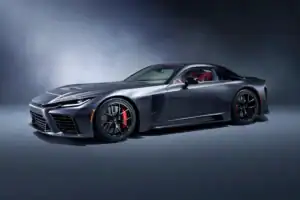Previous leather upholstery option falls away, as does the long serving turbodiesel engine certain European markets still had access to.

Its world debut having taken place just under five years ago, Renault has officially taken the wraps off of the facelift Captur markets in Europe will be receiving over the next few months.
Sharper looks
Arriving just short of a year after the unveiling of the facelift Clio, the Captur retains the same dimensions as before, but incorporates the rhombus brand’s latest styling language, including the first time availability of the Esprit Alpine trim grade in place of the now discontinued R.S. Line.
ALSO READ: All-new Renault Captur spied with Clio-esque looks
Set to be joined later this year by the still under-wraps Symbioz, the Captur’s aesthetic revisions comprise a sharper frontal design derived from the Rafale, made-up of new LED headlights, a slimmer grille, redesigned bumper, restyled C-shaped LED fog lamps, a new air intake above the numberplate and Renault’s latest Nouvel’R diamond logo.

Mounted on newly designed wheels ranging from imitation 17-inch alloys to 19-inch gloss back alloys on the Esprit Alpine, the Captur’s rear facia has undergone more minor changes in the form of a restyled bumper and faux diffuser, the Nouvel’R logo and what Renault calls transparent inner light clusters.
Whereas the Esprit Alpine’s unique aesthetics involves gloss black and Slate Grey detailing, the entire Captur range can be decked-out in one of six colours.

The available options are Pearl White, Gunmetal Grey, Starry Black, Oyster Grey, Flame Red and Iron Blue, as well as Champagne only the entry-level Evolution and mid-spec Techno trim level can be finished in.
As before, three two-tone options can be had in which certain colours are contrasted by either a Highland Grey, Perle Beige or Starry Black roof and mirror caps.
More tech but no leather
Inside, the subtle reworkings involves the infotainment system now measuring 10.4-inches instead of the previous 9.3-inches, still with Apple CarPlay and Android Auto, but with Renault’s latest software as well as over-the-air updates.

In another first, the Captur loses its leather upholstery option in favour of a recycled fabric material, while also taking leave of all chrome detailing.
Along with the infotainment system, the digital instrument becomes an entirely digital affair measuring 10.25-inches, with the final new additions being four type-C USB ports, a wireless smartphone charger on all but the Evolution grade, expanded ambient lighting and a nine-speaker Harman Kardon sound system.

Exclusive to the Esprit Alpine are blue-and-grey inserts, special textured and grained fabric seats with the French tricolour and blue ‘A’ branded seatbacks at the front, blue stitch work, Alpine branding on the steering wheel and treadplates, alloy pedals and a blue insert on the dashboard.
Safety and space
In terms of safety and driver assistance systems, carried over or revised features consists of Traffic Sign Recognition, Adaptive Cruise Control, Driver Attention Alert, Automatic Emergency Braking, Rear Cross Traffic Alert, Lane Departure Warning, Blind Spot Warning, Lane Keep Assist, Safe Exit Alert, front and rear parking sensors, and a 360-degreee surround-view camera system.

On the practical side, the Captur’s CMF-B platform, which also underpins its twin, the Mitsubishi ASX, and the Clio, translates to a boot capacity of 422-litres, or a maximum of 1 596-litres with the rear seats folded down.
Due to the electric hardware, the E-Tech hybrid’s loading capacity varies from 326-litres to 1 458-litres with the split rear back folded down.
Hybrid in, diesel out
Up front, Renault has streamlined the line-up of engines by dropping the 1.5 Blue dCi turbodiesel entirely – and seemingly also the plug-in hybrid – while adding a 12-volt mild-hybrid system to two versions of the Daimler co-developed 1.3-litre turbo-petrol.
All shared with the Clio, which curiously retains the oil-burner but omits any hybrid assistance, the base 1.0-litre turbo-petrol produces 66kW/160Nm in the TCe 90, or 74kW/170Nm in the liquid petroleum gas (LPG) filled TCe 100 LPG.

Up next, the TCe 155 serves as the only version of the mentioned 1.3-litre mill not to offer the mild-hybrid system with outputs of 115kW/270Nm.
Somewhat oddly, Renault declined to provide any details of the 12-volt system’s added power, confirming only the outputs of the units without the electric hardware’s involvement; 103kW/260Nm in the TCe 140 and 118kW/270Nm in the TCe 160.

At the range’s summit, the E-Tech once again marries a normally aspirated 1.6-litre petrol engine with 36 kW electric motor driven by a 1.2-kWh battery pack for a total system output of 145 PS or 107 kW.
While equipped with a new Extended Grip setting on the E-Tech that adds two traction modes to the Multi-Sense drive selector, Snow and All-Terrain, the Captur remains front-wheel-drive only, with the rest of the range having access to the standard four mode selector; Eco, Comfort, Sport and MySense.

On the transmission front, a six-speed manual comes standard on the TCe 90, TCe 100 LPG and TCe 140, with a seven-speed EDC being the sole option for the TCe 155 and TCe 160.
Again, reserved for the E-Tech is the unique four-speed automatic that loses the clutch and synchromesh for a dog ring design, as well as reverse handled by two separate gears provided by the electric motor.
Prepare to wait
Soon to enter production at the Valladolid plant in Spain, pricing for the Captur remains unknown, though projections point to a starting sticker of around the €20 000 (R405 276) mark.
As it only arrived in South Africa last year after a series of delays brought on first by the pandemic and then pricing, expectations are that Renault will only introduce the facelift Captur next year should approval be given.
ALSO READ: Renault Captur does ‘compact’ and ‘SUV’ right with added flare






